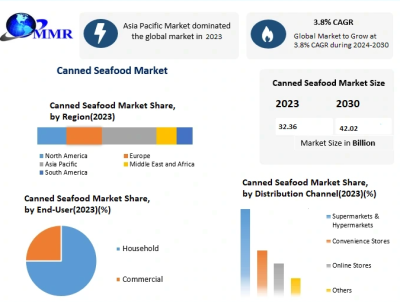Categories
Tags
-
#Cheese Industry
#Cheese Industry Share
#Cheese Industry Size
#Cheese Industry News
#Essential Oils Industry
#Essential Oils Industry Share
#Essential Oils Industry Demand
#Essential Oils Industry Analysis
#Canned Seafood Industry
#Canned Seafood Industry Share
#Canned Seafood Industry Size
#Canned Seafood Industry News
#Organic Coffee Industry
#Organic Coffee Industry Analysis
#Organic Coffee Industry Cagr
#Organic Coffee Industry News
#Pet Food Industry
#Pet Food Industry Share
#Pet Food Industry Opportunities
#Pet Food Industry Forecast
Archives
Canned Seafood Industry Growth Projections: Industry Forecast
-
Posted by preeti mmr Filed in Other #Canned Seafood Industry #Canned Seafood Industry Share #Canned Seafood Industry Size #Canned Seafood Industry News 16 views
Market Estimation & Definition
The Canned Seafood Industry was valued at US $32.36 billion in 2023, with projections to reach US $42.02 billion by 2030, growing at a CAGR of 3.8% during the forecast period. The market covers a broad category of shelf-stable, pre-cooked seafood products including tuna, salmon, sardines, prawns, shrimp, and other species, packaged in metal cans for extended shelf life and convenience.
Ask for Sample to Know US Tariff Impacts on Canned Seafood Industry @ https://www.maximizemarketresearch.com/request-sample/145875/
Trends in the Canned Seafood Market
Rising Popularity of Flavored Tuna Varieties: This trend in the market not only caters to changing taste preferences but also aligns with the broader consumer demand for convenience, innovation, and premiumization in the food industry. The trend of flavored tuna is characterized by a fusion of culinary influences from across the world. Inspired by global cuisines, companies are increasingly introducing varieties of tuna that incorporate diverse flavors and ingredients.
Challenges faced by Canned Seafood Market:
High price and popularity of minimally processed food: Lower and middle-income levels of the population in developing countries are unable to afford canned seafood products. In addition to that, growing awareness of the adverse health effects due to the consumption of highly processed foods gives rise to increasing demand for minimally processed food. The canning process uses high temperature and pressure which might change the properties of the final product. From the study, it is found that consumers’ buying behavior changes towards natural and minimally processed food. So, some of these factors will hamper the growth of the canned seafood market.
Explore the full report for an in-depth analysis: https://www.maximizemarketresearch.com/market-report/canned-seafood-market/145875/
Segmentation Analysis
The market is segmented based on:
by Product Type
Tuna
Salmon
Sardines
Prawns
Shrimp
other seafoodby Distribution channel
Supermarkets & Hypermarkets
Convenience Stores
Online Stores
Othersby End User
Households
CommercialRegional Insights
Asia Pacific Canned Seafood Market dominated the market with the market share of around 46.2% in 2023. In addition, the high demand for seafood and ready-to-eat products in the region is expected to drive the growth of the regional market over the forecasted period. Also, the presence of the major key players makes the Asia Pacific region dominated the market. Canned Seafood Suppliers ensure a consistent and reliable availability of canned seafood products, which contributes in an increase in consumer adoption.
European Canned Seafood Market was the second largest market with the share of around 32.8% in 2023. The Europe region is well-known for its rich cultural diversity and culinary traditions. The regional market caters to this diversity by offering a wide range of products that align with various preferences. From Spanish-style canned tuna to Portuguese sardines, the market reflects the influence of local cuisines, which contributes to its vibrancy and appeal. The European Canning Fish Market also significantly influence the market for canned seafood.
Commutator Analysis
A structured market assessment reveals:
Asia Pacific
1. Dongwon Industries (South Korea)
2. Sajo Industries (South Korea)
3. Simon Peter Fish & Meat Company (India)
4. SANTHI Fisheries (India)
5. Metarch Exports (India)
6. Nippon Suisan Kaisha Ltd.(Japan)
7. Maruha Nichiro Corporation (Japan)
8. Thai Union Group (Thailand)Competitive Landscape
As per the study, the market is highly competitive with huge number of players in the Canned Seafood industry. The top 10 companies holds 81.82% of the share in the market. There are many Canned Seafood companies that have established themselves as leaders through extensive distribution networks, brand recognition and a wide product portfolio. Canned Seafood competitors are constantly introducing new products to meet changing consumer preferences and to cater to niche markets.
Conclusion
The global canned seafood market is on track to surpass US $42 billion by 2030, underpinned by rising health awareness, convenience-driven demand, and retail channel expansion. Sustainability certifications, value-added innovations, and eco-friendly packaging will be critical factors influencing consumer preferences and competitive advantage. Established markets like the U.S. and Germany will continue to set trends, while emerging economies open new avenues for growth. Industry players are poised to leverage these opportunities by aligning offerings with shifting consumer expectations and regulatory frameworks.
About UsMaximize Market Research is one of the fastest-growing market research and business consulting firms serving clients globally. Our revenue impact and focused growth-driven research initiatives make us a proud partner of majority of the Fortune 500 companies. We have a diversified portfolio and serve a variety of industries such as IT & telecom, chemical, food & beverage, aerospace & defense, healthcare and others.Contact Maximize Market ResearchMAXIMIZE MARKET RESEARCH PVT. LTD.2nd Floor, Navale IT park Phase 3,Pune Banglore Highway, NarhePune, Maharashtra 411041, India.+91 9607365656sales@maximizemarketresearch.com
